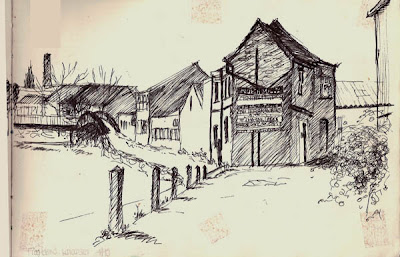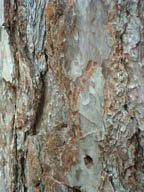the value of sketchbooks

I know some artists who don't use sketchbooks or make sketches - but most do. For me they are a really important facet of my work. Lots of the sketches will never be developed but serve to help me learn about a subject and get to know it well.
Sometimes they'll come in useful years later as this one - it was done 10 years or so ago, when I did a small body of work on this industrial area of the canal, it interested me and I always felt I may do more one day - and now this area is part of my waterways project. This is somewhere I intend to sketch again at some point. It's just a few hundred yards from where I sketched the factories and weir recently.
The building is an odd quirky shape, built to fit between the 2 diverging pathways. It wasn't totally finished - the white area on the left is the canal, I concentrated on the buildings and bridge and never finished the water surface.
The shelves of sketchbooks are a really useful resource for now and the future but also served as practice - hand-eye coordination, observation, how to get a 3D object down quickly in 2D, abstracting marks, playing with mixed media - all of which feeds into finished works in some way or another at some time.
There's no pressure in a sketchbook, there's a sort of permission to go out on a limb and be free, experiment, because it doesn't matter if it doesn't work .... and therefore it frequently does! ... it's only paper, just a sketch and so it encourages freedom of marks, media, ideas.
I jot down ideas and thoughts on ways to go with work, places to visit, artists I've seen, stick stuff in - anything that's useful.
I prefer hard back books and like the Daler Rowney black ones. I usually use A4 or bigger, A3 are really nice to use. I also like square books and have 9inch and 11 inch squares.
I use anything in them - including watercolour or oils. Oils work really well on paper and don't stick to the opposite page even if they are shut when wet - it makes the wet oils easy to carry as well, the wet paint is safely shut in the book, not getting all over your clothes as you carry the stuff back to the car (working plein air). I haven't yet tried oils in a moleskine, they are probably too small to work well. I wonder how they work though????
I find the best thing to stop pages flipping over in the wind is a big elastic band - the kind that postmen use to bundle letters with.



Comments
You should create an Imagekind.com gallery and make some money off of your work! I'm a photographer and I just started selling my work on the site. It's pretty easy to use. I'd love to see your art up there for sale. Email me if you do!
I will bear it in mind and give it some thought though :)